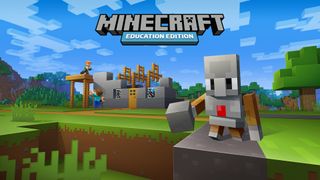Minecraft: Education Edition is a learning-specific version of this very popular block-based game. So while students will be drawn to the game anyway, this also allows teacher controls to help educate them as they interact with this virtual world.
Minecraft: Education Edition works well both in the classroom and remotely. Let students go on a virtual field trip through space and time. Or have groups work collaboratively on a project, regardless of where they are.
Minecraft: Education Edition is good for any age student and covers all grade levels. Many colleges have used Minecraft to offer virtual tours and even orientation groups, and during remote learning times, to help new students integrate virtually.
So what's the catch? Minecraft: Education Edition isn't free, but more on that below. Then you can decide if this near limitless virtual world is worth the investment.
Here's everything you need to know about Minecraft: Education Edition for teachers.
- How to turn a Minecraft Map into a Google Map
- How Colleges are Using Minecraft to Create Events and Activities
- Minecraft: Education Edition Lesson Plan
What is Minecraft: Education Edition?
Minecraft is a game that uses block-based graphics with virtual design controls. It allows anyone playing to build virtual worlds in which they can then play as a character, roaming about freely.
Many sub games exist, however, we're just going to focus on the Education Edition offerings.
What the Minecraft: Education Edition does, over the regular version, is offer special features for teachers that allow them to control the virtual world their students are using. This makes it safe, lets the teacher keep students focused on a task, and also creates options for communication.
The game runs on many platforms, from laptops and desktops to Chromebooks and tablets. Thanks to its low technology requirements, it is a great option to offer a virtual environment that isn't taxing on a network connection – making it highly inclusive.

What's Good About Minecraft: Education Edition for Students?
Game-based learning continues to be a very popular teaching tool, and with good reason. The gaming nature makes it immediately appealing and engaging for students, especially so for Minecraft, which is played by children around the world, with the Education Edition played in more than 115 countries.
The game builds project-based skills and allows students to work individually, or collaboratively, on problem-solving lessons. The result is STEM learning in an environment that helps build digital citizenship as well as confidence in the real world.
This makes learning and assessment easy as students can take a screenshot and send that to the teacher for assessment at any point during or after the project task. It is also a nice way for students to build a portfolio of the work they've completed.
A Code Builder mode allows students to even learn how to code while playing the game. Students can use code as a way to experiment with introductory chemistry and offers an underwater biome for the exploration of oceanography.

Why is Minecraft: Education Edition Good for Teachers?
With Minecraft: Education Edition, teachers are able to enjoy the benefits of being in a community with other teachers. From participating in discussion boards to collaborating with other schools, there's plenty available.
The website features numerous tools to make navigating the platform easier for teachers. Tutorial videos and lesson plans are available, some of which are downloadable worlds that can be used as templates to create lessons. The platform also offers connections to mentors, trainers, and other educators.
The Classroom mode allows teachers to see a map of the virtual world, allowing them to zoom in and out to interact with each student. They can also move a student avatar back to where they should be, if they end up wandering.
Teachers can even use chalkboards, such as in the real world, to lay out assignments and objectives to students. Teachers can even create non-playable characters that work like guides, linking students from one task to the next.

What Does Minecraft: Education Edition Cost?
While the thought of an endless world supported by plenty of education-focused tools that students actually want to engage with sounds expensive, it's actually not.
Minecraft: Education Edition offers two different pricing systems:
- For a small, single class school there is a $5 per user per year charge.
- For larger schools of more than 100 students, with multiple classrooms using the game, there is volume licensing available from Microsoft. This comes as part of the Microsoft Enrollment for Education Solutions program, and the prices will vary depending on the size of school and the plan chosen.
Of course on top of that, hardware needs to be taken into consideration. Most laptops, desktops, and tablets are capable of running Minecraft. A minimum requirement for the full computer versions are Windows 10, macOS or iOS for tablets, and Chrome OS for Chromebooks.
Get started by downloading Minecraft: Education Edition here.
Minecraft Java vs. Minecraft Bedrock: What's the difference?
Minecraft comes in two forms, which are sold separately and aren't interchangeable. So which should you go for? The original, Minecraft Java, is available through the company's website and is for PC only. Minecraft Bedrock edition, however, is attained through mobile devices, consoles, and the Microsoft Store, working on all those and Windows 10.
The key is to make sure you have the same version your students have so that you can collaborate together online. Hardcore mode, in which you can't respawn when you die, isn't available in Bedrock. Neither is Spectator, which lets you fly around to view the world.
If it's your first time buying the game, then it's worth noting that the Java edition has more mods for free than Bedrock, which has lots of paid content add-ons. That said, Bedrock is better for cross-platform gameplay and generally runs a little smoother.

